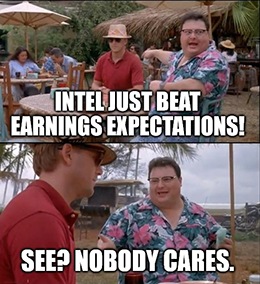
Friday Four Play:
The “Little Trouble in Big China” Edition
You listen to the old Great Stuff Express here now. Take our advice on this dark and stormy market, when stocks are crashin’ and volatility is rollin’.
Just remember what ol’ Mr. Great Stuff does when the Chinese and the U.S. close embassies, corporate earnings fall from the sky and the pillars of discount hand sanitizer shake.
Yeah, Mr. Great Stuff just looks that big old storm right square in the eye and says: “Give me your best shot, pal. I can take it!”
Volatility verges on breaking out again, dear reader.
The markets were relatively quiet for more than a month now, with the Dow up less than 1% since the first week of June. In the past two weeks, the blue-chip barometer is actually down 0.38%. That’s a far cry from the intense volatility we saw in the prior three months.
But something will break sooner or later — the center cannot hold.
Be it rising COVID-19 infections, a delayed stimulus bill out of the U.S. Senate or rising tensions with China — why not all three? — the market’s gearing up for another round of sharp, unpredictable moves.
The latest tit for tat between the U.S. and China is most likely to kick off another volatility party.
Sure, we’re just at the “you close our embassy, we’ll close yours” stage of the disagreement. However, President Trump said yesterday that the U.S.-China trade deal “…means less to me now than it did when I made it.”
Them’s fightin’ words. That puts the trade deal firmly among the list of options for U.S. retaliation or escalation against China.
So, when some wild-eyed, eight-foot-tall market volatility monster grabs your neck, taps the back of your favorite portfolio against Wall Street, looks you crooked in the eye and asks if you paid your dues … you just stare that big sucker right back in the eye…
And you remember what ol’ Mr. Great Stuff always says: “Have you paid your dues, Joe? Yes sir, the check is in the mail.”
Editor’s note: Y’all asked for it, and it’s back! Our No. 1 volatility-beating strategy: “One Trade.”
Just last week, One Trade readers were handed a gain of 123% in 24 hours … and people quickly wrote in saying they made upwards of 138% and 271% on the same trade.
When you click here, you’ll see how to target big gains like these — in as little as 24 hours!
And now for something completely different … it’s time for your Friday Four Play.
No. 1: Intel Outside

Former king of the chips Intel Corp. (Nasdaq: INTC) slipped into the earnings confessional last night to dish more than just quarterly finance figures. Oh, earnings were good. Better than good. Intel’s second-quarter earnings and revenue both handily beat Wall Street’s targets.
But no one cares.
You see, Intel once again delayed the release of its seven-nanometer semiconductors. Now, seven-nanometer chips consume much less energy than their predecessors with the same impressive computing power. But Intel, it seems, just can’t get the chips in the dip.
“We have identified a defect mode in our seven-nanometer process that resulted in yield degradation,” Intel CEO Bob Swan told analysts. In short, Intel has designs for the chips, but it can’t seem to produce them.
The news has prompted mass speculation that Intel may have to outsource production — something Intel has never done before — in order to remain competitive with Advanced Micro Devices Inc. (Nasdaq: AMD), which already has a seven-nanometer chip on the market.
As a result, INTC shares were down more than 15% following the news. And, proving that schadenfreude is the best freude, AMD rallied about 15% in the face of Intel’s failure.
No. 2: Patent-ly Perilous

Leading COVID-19 vaccine maker and patent-process denier Moderna Inc. (Nasdaq: MRNA) finds itself in quite a pickle. And we’re not talking tasty dill pickle slices on your hamburger either. We’re talking deformed little sweet gherkin pickles. Seriously, guys, those things are disturbing.
Moderna’s COVID-19 vaccine, dubbed mRNA-1273, uses lipid nanoparticle (LPN) technology as a delivery system. Essentially, LPN is a revolutionary means of getting the human body to process an RNA-type vaccine. (We won’t get into an RNA/DNA discussion here. I’m not a microbiologist. Go here if you want to dive down that rabbit hole.)
The problem is that Moderna doesn’t hold the patent on LPN technology. Arbutus Biopharma Corp. (Nasdaq: ABUS) does. Yesterday, Moderna challenged Arbutus’ patent in an attempt to head this issue off before its vaccine is ready. Moderna was not successful. Oof.
When questioned how this ruling would affect its COVID-19 vaccine plans, Moderna went into full “Bagdad Bob” mode, stating “Moderna is not aware of any significant intellectual property impediments for any products we intend to commercialize, including mRNA-1273.”
So, Moderna isn’t aware of the patent it just tried to overturn in court?
Now, this isn’t bad news for the vaccine. It’s still going forward, with phase 3 trials set for later this month. However, this could be bad news for Moderna’s profits if the company has to compensate Arbutus (he-he … “butus”) for using LPN technology in the vaccine’s delivery system.
Investors typically aren’t too keen on threats to future profits, so MRNA shares took a nosedive on the news. No, I don’t think this particular dip is a buying opportunity. We need more info on the patent dispute before viewing MRNA as a bargain at this point.
No. 3: Reach Out and (Don’t) Touch Someone

Verizon Communications Inc.’s (NYSE: VZ) report today should be the poster child of a pandemic earnings season.
It’s all straight talk — both earnings and revenue fell short of last year’s mark (no surprise). But with our “how low can you go” expectations limbo, Verizon beat analyst projections. We can hear you now.
Here are the numbers:
- Earnings: $1.18 per share, beating estimates for $1.15 per share.
- Revenue: $30.4 billion, beating estimates of $29.9 billion.
Pretty much every business segment was down year over year, from consumer wireless to Verizon’s media hustle. (What, no one’s using good ol’ Yahoo to keep tabs on the pandemic?)
The thing is, Verizon’s core user base kept growing throughout the pandemic. The company’s main tailwind was “a stable subscriber base supported by consumer demand to remain connected and online…”
Believe it or not, people need to, you know, talk and text more now than ever. Lord knows there’s hardly anything to catch up on whenever family calls, but I digress.
Verizon’s earnings would be yawn-worthy in other quarters, but seeing the company hold its own amid the carnage? I’m lovin’ it. To see why Verizon’s sleeper earnings are actually a blowout, we only have to side-eye the dumpster fire that is AT&T (NYSE: T).
No. 4: Blue Are the Earnings That Live Inside Me

AT&T’s big blue world got a lot smaller last quarter.
Listen up, here’s the story: AT&T blew earnings, inside and outside. Again. Da ba dee, da ba daa.
All day and all night, everything it sees is just blue. Just about everything that could’ve gone wrong in AT&T’s earnings rodeo did.
“…AT&T posted postpaid net subscriber losses of 151,000 after it stopped counting 338,000 ‘accrued disconnects,’” which is a somewhat-nicer way to describe all those who can’t pay their wireless bills due to the coronavirus, job losses and budget constraints.
Wireless was the only thing growing. It’s so in debt, it literally can’t address the now-blooming wireless problem unless HBO Max starts generating a lot of income — fast.
HBO Max? Don’t even mention it. Hey if it ain’t on my Roku box, does it even exist? To many folks, that’s a big fat “nope.”
Even its WarnerMedia group left the earnings ring black eyed “…amid advertising pressures, film delays, and the loss of live sports.” Revenue here dropped 23% compared to last year.
Remember, AT&T’s entire business structure is like four leprous raccoons in a trench coat sneaking into a theater. It has valuable assets and intellectual property … but it’s all buried under a thick lacquer of debt-ridden mismanagement.
Now, there has to be some positivity in here, right? Some glimmer of hope? Oh! What if we account for roaming charges?! “Critically, mobility service revenues, adjusted for roaming, grew by more than 1%,” said Bernstein Analyst Peter Supino.
Da ba dee, da ba daa, indeed.
AT&T should’ve pressed the “reset button” on the whole shebang long ago. And there’s no doubt that sooner or later, America will cut the cord on this dinosaur.
(Need a better way to play the cord-cutting trend? We’ve got you covered right here. Seriously, click me!)
Great Stuff: Ramble On!
Thanks to all of you who invaded our inbox last night after our Reader Feedback issue. It’s always a blast to see what’s going on in our nation of Great Ones.
Wait … you haven’t written in yet? Let’s get to it!
GreatStuffToday@banyanhill.com. The rip-roaring conversation doesn’t have to end here, right? Why not take it online and ramble on!
You might even see your email in next week’s Reader Feedback.
We’ll keep the greatness flowing your way in the meantime, and you can always check us out on Facebook, Instagram and Twitter.
Until next time, stay Great!

Joseph Hargett
Editor, Great Stuff



